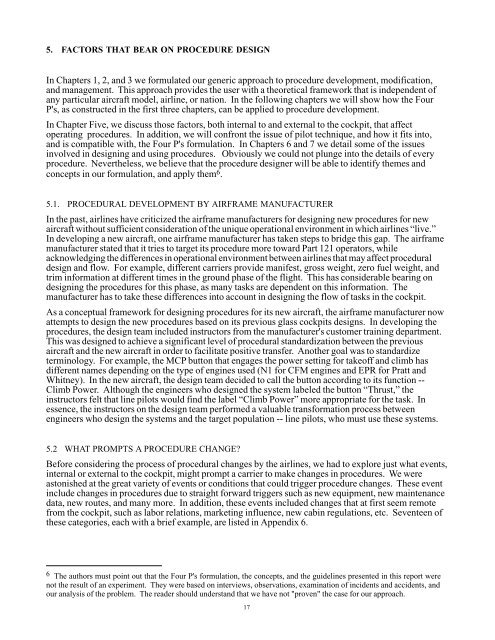On the Design of Flight-Deck Procedures - Intelligent Systems ...
On the Design of Flight-Deck Procedures - Intelligent Systems ...
On the Design of Flight-Deck Procedures - Intelligent Systems ...
You also want an ePaper? Increase the reach of your titles
YUMPU automatically turns print PDFs into web optimized ePapers that Google loves.
5. FACTORS THAT BEAR ON PROCEDURE DESIGNIn Chapters 1, 2, and 3 we formulated our generic approach to procedure development, modification,and management. This approach provides <strong>the</strong> user with a <strong>the</strong>oretical framework that is independent <strong>of</strong>any particular aircraft model, airline, or nation. In <strong>the</strong> following chapters we will show how <strong>the</strong> FourP's, as constructed in <strong>the</strong> first three chapters, can be applied to procedure development.In Chapter Five, we discuss those factors, both internal to and external to <strong>the</strong> cockpit, that affectoperating procedures. In addition, we will confront <strong>the</strong> issue <strong>of</strong> pilot technique, and how it fits into,and is compatible with, <strong>the</strong> Four P's formulation. In Chapters 6 and 7 we detail some <strong>of</strong> <strong>the</strong> issuesinvolved in designing and using procedures. Obviously we could not plunge into <strong>the</strong> details <strong>of</strong> everyprocedure. Never<strong>the</strong>less, we believe that <strong>the</strong> procedure designer will be able to identify <strong>the</strong>mes andconcepts in our formulation, and apply <strong>the</strong>m 6 .5.1. PROCEDURAL DEVELOPMENT BY AIRFRAME MANUFACTURERIn <strong>the</strong> past, airlines have criticized <strong>the</strong> airframe manufacturers for designing new procedures for newaircraft without sufficient consideration <strong>of</strong> <strong>the</strong> unique operational environment in which airlines “live.”In developing a new aircraft, one airframe manufacturer has taken steps to bridge this gap. The airframemanufacturer stated that it tries to target its procedure more toward Part 121 operators, whileacknowledging <strong>the</strong> differences in operational environment between airlines that may affect proceduraldesign and flow. For example, different carriers provide manifest, gross weight, zero fuel weight, andtrim information at different times in <strong>the</strong> ground phase <strong>of</strong> <strong>the</strong> flight. This has considerable bearing ondesigning <strong>the</strong> procedures for this phase, as many tasks are dependent on this information. Themanufacturer has to take <strong>the</strong>se differences into account in designing <strong>the</strong> flow <strong>of</strong> tasks in <strong>the</strong> cockpit.As a conceptual framework for designing procedures for its new aircraft, <strong>the</strong> airframe manufacturer nowattempts to design <strong>the</strong> new procedures based on its previous glass cockpits designs. In developing <strong>the</strong>procedures, <strong>the</strong> design team included instructors from <strong>the</strong> manufacturer's customer training department.This was designed to achieve a significant level <strong>of</strong> procedural standardization between <strong>the</strong> previousaircraft and <strong>the</strong> new aircraft in order to facilitate positive transfer. Ano<strong>the</strong>r goal was to standardizeterminology. For example, <strong>the</strong> MCP button that engages <strong>the</strong> power setting for take<strong>of</strong>f and climb hasdifferent names depending on <strong>the</strong> type <strong>of</strong> engines used (N1 for CFM engines and EPR for Pratt andWhitney). In <strong>the</strong> new aircraft, <strong>the</strong> design team decided to call <strong>the</strong> button according to its function --Climb Power. Although <strong>the</strong> engineers who designed <strong>the</strong> system labeled <strong>the</strong> button “Thrust,” <strong>the</strong>instructors felt that line pilots would find <strong>the</strong> label “Climb Power” more appropriate for <strong>the</strong> task. Inessence, <strong>the</strong> instructors on <strong>the</strong> design team performed a valuable transformation process betweenengineers who design <strong>the</strong> systems and <strong>the</strong> target population -- line pilots, who must use <strong>the</strong>se systems.5.2 WHAT PROMPTS A PROCEDURE CHANGE?Before considering <strong>the</strong> process <strong>of</strong> procedural changes by <strong>the</strong> airlines, we had to explore just what events,internal or external to <strong>the</strong> cockpit, might prompt a carrier to make changes in procedures. We wereastonished at <strong>the</strong> great variety <strong>of</strong> events or conditions that could trigger procedure changes. These eventinclude changes in procedures due to straight forward triggers such as new equipment, new maintenancedata, new routes, and many more. In addition, <strong>the</strong>se events included changes that at first seem remotefrom <strong>the</strong> cockpit, such as labor relations, marketing influence, new cabin regulations, etc. Seventeen <strong>of</strong><strong>the</strong>se categories, each with a brief example, are listed in Appendix 6.6 The authors must point out that <strong>the</strong> Four P's formulation, <strong>the</strong> concepts, and <strong>the</strong> guidelines presented in this report werenot <strong>the</strong> result <strong>of</strong> an experiment. They were based on interviews, observations, examination <strong>of</strong> incidents and accidents, andour analysis <strong>of</strong> <strong>the</strong> problem. The reader should understand that we have not "proven" <strong>the</strong> case for our approach.17
















